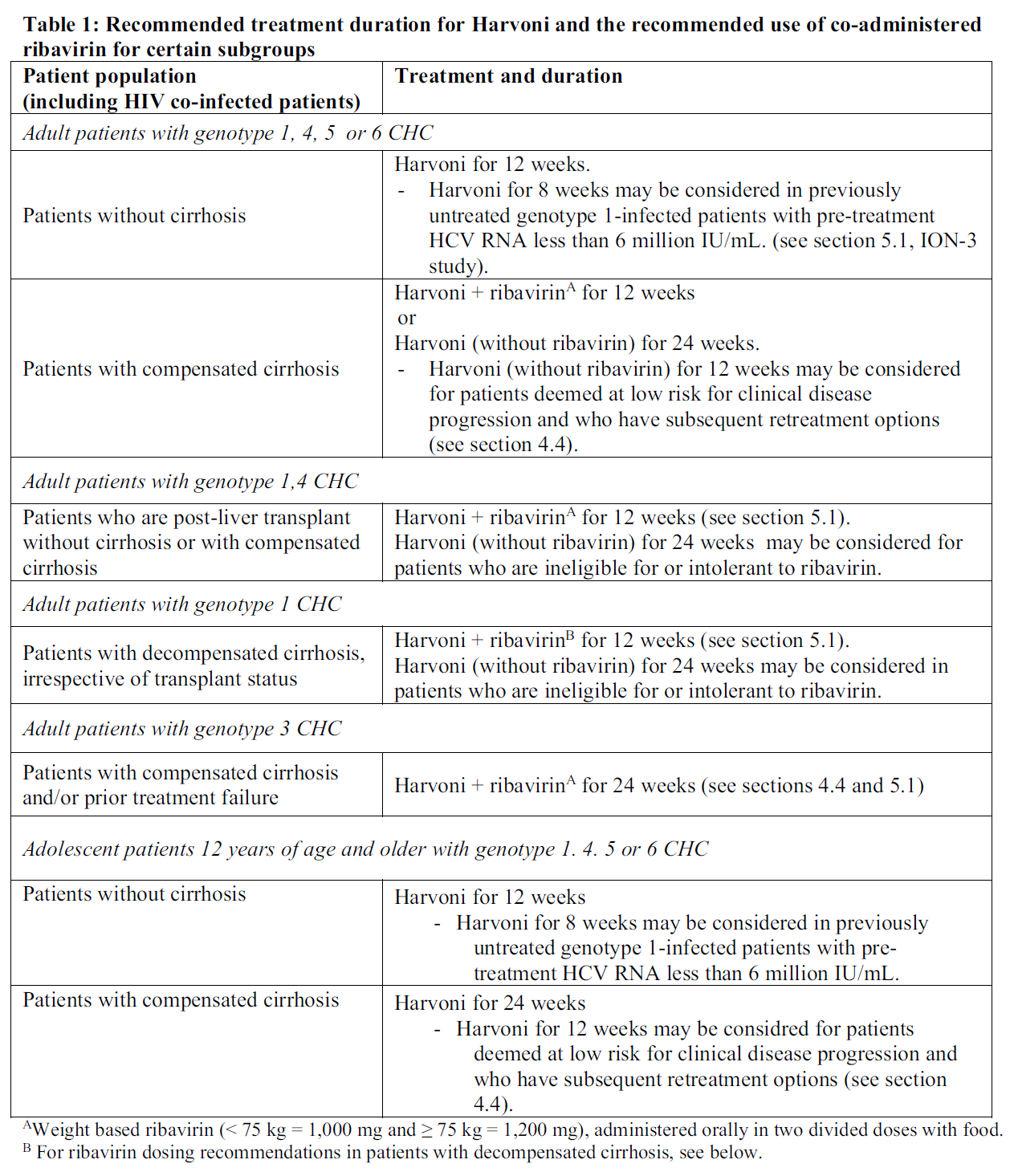Regulatory Information
HSA regulatory responsibility and product classification details
Regulatory Responsibility
Product Classification
Formulation Information
TABLET, FILM COATED
**4.2 Posology and method of administration** Harvoni treatment should be initiated and monitored by a physician experienced in the management of patients with CHC. Posology _Adults and adolescents aged 12 to < 18 years_ The recommended dose of Harvoni is one tablet once daily with or without food (see section 5.2 – _please refer to the Product Insert/Patient Information Leaflet published on HSA for the full drug information_).  In adult patients with decompensated cirrhosis, ribavirin should be administered at a starting dose of 600 mg given in a divided daily dose. If the starting dose is well-tolerated, the dose can be titrated up to a maximum of 1,000–1,200 mg daily (1,000 mg for patients weighing < 75 kg and 1,200 mg for patients weighing ≥ 75 kg). If the starting dose is not well-tolerated, the dose should be reduced as clinically indicated based on haemoglobin levels. When ribavirin is added to Harvoni, refer also to the package insert of ribavirin. _Dose modification of ribavirin in adults taking 1,000–1,200 mg daily_ If Harvoni is used in combination with ribavirin and a patient has a serious adverse reaction potentially related to ribavirin, the ribavirin dose should be modified or discontinued, if appropriate, until the adverse reaction abates or decreases in severity. Table 2 provides guidelines for dose modifications and discontinuation based on the patient’s haemoglobin concentration and cardiac status.  Once ribavirin has been withheld due to either a laboratory abnormality or clinical manifestation, an attempt may be made to restart ribavirin at 600 mg daily and further increase the dose to 800 mg daily. However, it is not recommended that ribavirin be increased to the originally assigned dose (1,000 mg to 1,200 mg daily). _Paediatric Population aged <12 years_ The safety and effectiveness of Harvoni in paediatric patients aged < 12 years have not been established. No data on paediatric patients aged < 12 years are available. _Missed dose_ Patients should be instructed that if vomiting occurs within 5 hours of dosing an additional tablet should be taken. If vomiting occurs more than 5 hours after dosing, no further dose is needed (see section 5.1 – _please refer to the Product Insert/Patient Information Leaflet published on HSA for the full drug information_). If a dose is missed and it is within 18 hours of the normal time, patients should be instructed to take the tablet as soon as possible and then patients should take the next dose at the usual time. If it is after 18 hours then patients should be instructed to wait and take the next dose at the usual time. Patients should be instructed not to take a double dose. _Elderly_ No dose adjustment is warranted for elderly patients (see section 5.2 – _please refer to the Product Insert/Patient Information Leaflet published on HSA for the full drug information_). _Renal impairment_ No dose adjustment of Harvoni is required for patients with mild or moderate renal impairment. Very limited safety data of ledipasvir/sofosbuvir are available on patients with severe renal impairment (estimated glomerular filtration rate \[eGFR\] < 30 mL/min/1.73 m2) (see sections 5.1 and 5.2 – _please refer to the Product Insert/Patient Information Leaflet published on HSA for the full drug information_). Safety has not been assessed in patients with end stage renal disease (ESRD) requiring dialysis (see section 5.2 – _please refer to the Product Insert/Patient Information Leaflet published on HSA for the full drug information_). _Hepatic impairment_ No dose adjustment of Harvoni is required for patients with mild, moderate or severe hepatic impairment (Child-Pugh-Turcotte \[CPT\] class A, B or C) (see section 5.2 – _please refer to the Product Insert/Patient Information Leaflet published on HSA for the full drug information_). Safety and efficacy of ledipasvir/sofosbuvir have been established in genotype 1 CHC patients with decompensated cirrhosis (see section 5.1 – _please refer to the Product Insert/Patient Information Leaflet published on HSA for the full drug information_). Method of administration For oral use. Patients should be instructed to swallow the tablet whole with or without food. Due to the bitter taste, it is recommended that the film-coated tablet is not chewed or crushed (see section 5.2 – _please refer to the Product Insert/Patient Information Leaflet published on HSA for the full drug information_).
ORAL
Medical Information
**4.1 Therapeutic indications** Harvoni is indicated for the treatment of chronic hepatitis C (CHC) in adults and in adolescents aged 12 to <18 years (see sections 4.2, 4.4 and 5.1 – _please refer to the Product Insert/Patient Information Leaflet published on HSA for the full drug information_). For hepatitis C virus (HCV) genotype-specific activity see sections 4.4 and 5.1 – _please refer to the Product Insert/Patient Information Leaflet published on HSA for the full drug information_.
**4.3 Contraindications** Hypersensitivity to the active substances or to any of the excipients listed in section 6.1 – _please refer to the Product Insert/Patient Information Leaflet published on HSA for the full drug information_. Co-administration with rosuvastatin (see section 4.5 – _please refer to the Product Insert/Patient Information Leaflet published on HSA for the full drug information_). Use with strong P-gp inducers Medicinal products that are strong P-glycoprotein (P-gp) inducers in the intestine (carbamazepine, phenobarbital, phenytoin, rifampicin, rifabutin and St. John’s wort). Co-administration will significantly decrease ledipasvir and sofosbuvir plasma concentrations and could result in loss of efficacy of Harvoni (see section 4.5 – _please refer to the Product Insert/Patient Information Leaflet published on HSA for the full drug information_).
Pending
xpending
Manufacturer Information
GILEAD SCIENCES SINGAPORE PTE. LTD.
Patheon Inc.
Gilead Sciences Ireland UC
Gilead Sciences, Inc. (Primary and secondary packager)
Hovione FarmaCiencia S.A. (Drug product intermediate)
Hovione Limited (Drug product intermediate)
Active Ingredients
Documents
Package Inserts
Harvoni PI.pdf
Approved: March 4, 2020
